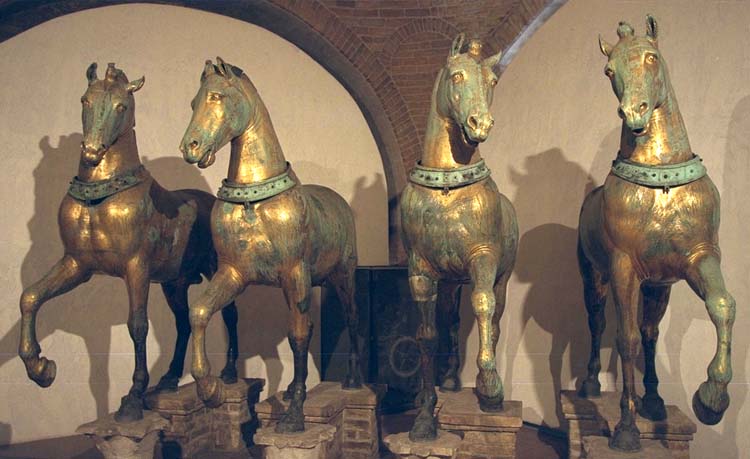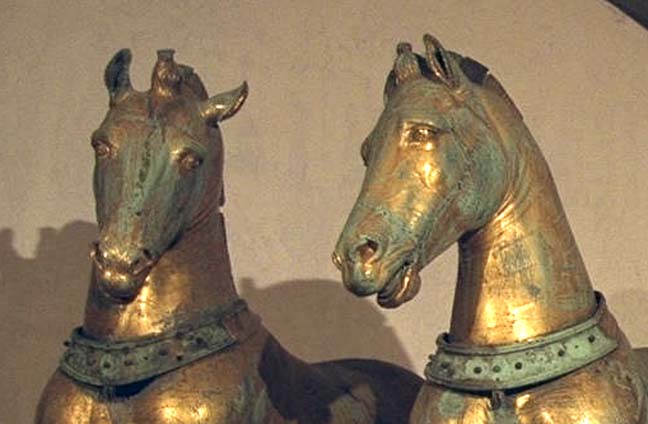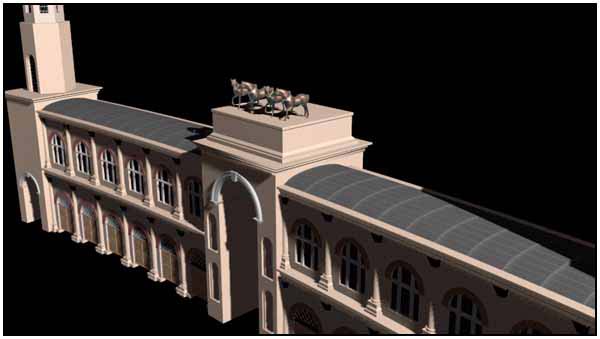The Horses at St. Mark's in Venice

The original horses (above) are now in a display area right behind the replicas that are on the outside logia of the Basilica of St. Mark in Venice.Lysippos was the only sculptor that Alexander the Great would allow to do his portrait. It has been impossible to reliably trace any of the more than 1500 bronze works that the Roman historian Pliny the Elder attributed to Lysippos (or Lysippus, in Latin) of Sicyon. "Reliably" is the important word here -- there are a few works that may be have been made by him or by his students under his direction, but there simply isn't sufficient proof or documentation -- all the evidence is artistic.
There are, on the other hand, many attested ancient Greek and Roman copies in bronze and marble of Lysippos' works, and some of them are in museums here in Rome and elsewhere in Italy. Lysippos and his many students set a new style, the tall and slim human proportion that became "standard" in classical sculpture. Some details of human facial features and of human body structure and conformity are so characteristic of his style that their presence or absence become significant in debates over whether sculptures might be from Lysippos' own foundries, or, conversely, how well copyists were able to capture Lysippos' originals.
What's true of humans is also true of horses. Some of the Alexander portraits and other works by Lysippos were equestrian statues, and several good copies of Lysippos horses are available for study. One of the best of them, with Alexander aboard, is in the Florence Museum. Some authorities say that it was the model for the horse Marcus Aurelius rides in the Rome Capitoline Museum. It is the ears of Alexander's horse -- characteristic Lysipposian equine ears -- that are important in our current discussion.

The ears are the key. Heads of two of the Venice horses.Neither those ears nor the ears of the four horses at St. Marks in Venice look much like real horses' ears, but the sculpted ears do look alike. And they look like we think horses ears should look and would look if Nature was as good a stylist as Lysippos. Nature, of course was working toward maximum functionality while Lysippos could focus on form. Anyway, it is the similarity of the ears that Lysippos put on Alexander's horse, Bucephalus (from Vous = ox, and Kephali = head, referring to head width/size and not shape) that leads some art historians to their determination that the four St. Mark horses might, just might, be from the Lysippos forge. The bronze of the St. Mark horses may also be old enough, but it's a strange mix: 98% copper, one percent tin, and one percent lead -- a mixture unknown in other classical Greek bronze. It tells the experts nothing. It's mainly those ears that are most convincing to those who want the St. Mark horses to be from Lysippos.
The ancient Romans certainly knew all about Lysippos -- Pliny's writings were among the most popular Roman reads, and there was a lively market for real and supposed Lysippos sculpture. As Romans got richer, more and more bronzes said to be by him were imported to be raised on private garden pedestals or for public dedications. The more rich and powerful you were, the bigger your Lysippos sculpture should be. The Emperors skimmed the best from the market, and thus it was that Nero, by hook or by crook, was said to have brought the four "Lysippos" horses to Rome. Some sources say they were displayed in his Domus Aurea.
The Domus Aurea, as you may know, only lasted as long as Nero, who took his own life in 68 AD to avoid being torn limb from limb by the Roman mob. The only part of the Golden Palace that wasn't torn down or recycled by the following Flavian dynasty -- the part that is now being called the Domus Aurea and that is partially open for tourism -- is a dining pavilion on the slope of the Oppian Hill. That part survived because it was used as a foundation for Trajan's Baths. Where the horses went after Nero and his Golden Palace fell is not known.
And they didn't show up again until Constantine took them back east in the mid-320's to adorn the starting gates at his new Hippodrome in Constantinople. The Constantinople Hippodrome was a chariot-racing venue designed to emulate the Roman Circus Maximus, so this new display of the horses was particularly appropriate: the horses are thought to have first been made as part of a quadriga sculpture group -- the four horses, a chariot, and an heroic driver. (Chariots were classified by horsepower -- a one horse rig was a "ga", two horses made a "biga", three a "triga", four a "quadriga", etc. Bigger and more complex rigs made for races that were more chaotic and bloodier and thus were more appealing to the Roman masses.) The horses stayed up there where Constantine put them on the starting line for a long time -- in fact, until the time of the crusades, almost 900 years later.

An artist's impression of the horses above the starting gates at the Constantinople hippodrome (what the Romans called a "Circus")The European warlords who organized the Fourth Crusade in the early 13th century had learned from past mistakes: going by sea to Outremere, the overseas Crusader kingdom in the Holy Land, was a much safer and much less costly prospect than the long overland march. They contracted with Enrico Dandolo, the Doge of Venice, who promised to deliver the crusaders to their destination in return for a big chunk of whatever loot the Crusade would generate. Some payments had to be made along the way, at least enough to cover immediate Venetian operating expenses. It was these payments, or rather the inability of the Crusader barons to make them, that led to the diversion of the Fourth Crusade toward Asia Minor. First it was Zara, an old competitor of Venice, and then it was Constantinople that fell to the Crusader hordes. The wealth of both and of sundry surrounding towns was plundered and shared out between the crusaders and the Venetians. Prominent in the Venetian booty from Constantinople were the four horses. The Doge claimed the horses, piles of cash, the precious-metal iconostasis from Hagia Sophia, other treasures that are still proudly displayed in the cathedral of St. Mark, and three-eighths of the Byzantine Empire.
The big gilded horses were not immediately available to the public. For fifty years they were warehoused in the arsenal -- in danger the whole time from metal-hungry cannon makers. A later Doge, probably Enrico Zanieri, finally put them up on the logia above the main door of St. Marks Cathedral as a symbol of Venetian power. There they stayed, undisturbed, for another five hundred years.
But in the last five years of the 18th century, Napoleon swept through the Italian peninsula, and, while still subduing it by sections, he started to loot. From Venice he collected crates of masterpieces: among other things, twenty or so priceless painting, more than five hundred manuscripts, the city's symbolic winged lion accompanied by two "Victories" (also winged), and, inevitably, the four gilded horses were all shipped off to Paris at the end of 1797. Napoleon had the horses, along with a previously unassociated chariot and flanked by the Victories, set atop the Arc du Carrousel, the triumphal arch on the Tuileries end of the Champs-Elysees (opposite the much bigger Arc de Triomphe at the other end.) The 1815 Congress of Vienna sent most of Napoleon's loot back to Venice, and the horses, in due time, were reinstalled on the St. Mark logia. They came down again 95 years later for restoration and then were remounted on the logia in 1902. Fifteen years later, during World War 1, they were removed to Rome for safety, and they were again returned to St. Mark after that war. The pattern recurred again in World War Sequel: off they went to a Benedictine abbey at Praglia in 1942 and then back to the logia again post-war.
During all these moves over almost 2400 years, the horses stayed in pretty good condition, aside from the removal of some of the gold coating by enterprising scrapers. In the early 1980s, a major touring exhibition took them to Mexico City, New York, London, Paris, Milan and Berlin. After that last trip, however, they did not return to the Basilica of San Marco, because they were being damaged too much by modern air pollution. They were instead taken to a museum and, after they were cleaned and treated to cure the "bronze disease" that was weakening them, replicas were created which took the place of the originals on the logia of the cathedral. You can climb a steep inside stairway to where the replicas stand on the Basilica today -- a wonderful place to take pictures of St. Mark's Square and of cousin Ted or aunt Tillie among the legs of the fabulous fake horses.
The originals are now kept inside a room on the same upper level of the cathedral as the replicas. They are in the small museum accessible by the same stairway.
P.S.: The strange composition of the bronze in the horses has led some experts to question whether they really date back to Lysippos and the Alexandrian period: they say that the ancient Greeks simply didn't know how to make such mixtures, and their evidence of this is that no other examples of the mix are present in classical Greek works. This school of thought dates the horses to the late Roman empire, shortly before the time of Constantine and says that the stylistic similarities between these horses and the Marcus Aurelius horse show that they all were made about the same time, possibly using works by Lysippos as models. This "bronze formulation" argument falters, however, when you consider that this particular mix also does not appear in works from any other period either -- and yet, there the horses stand.
There is much information on these famous horses on the Internet but it is spread around in small bits on dozens of obscure sites.
Some of the more easily accessible material is at:
http://www.sikyon.com/Sicyon/Lysippos/lysip_egpg7.html and
http://www.metaltimes.de/MT22/E_Artikel-03.html (which also explains the process of casting the horses and copies) and
http://www.byzantium1200.org/boxes.html
Accounts of the 4th Crusade and what the Crusaders took are at:
http://www.fordham.edu/halsall/source/4cde.html#zara and
http://www.fordham.edu/halsall/basis/villehardouin.html
And speaking of horses, the annual show-jumping event at Piazza di Siena in the Villa Borghese park, will be held from May 23 - 26, 2002. Details are not yet available, but the top horses and riders in the world always participate, and there is a performance of the famous Carabinieri "Carousel" -- one hundred horses and riders in high speed precision maneuvers -- on the last night. Plan to attend. Info will be posted by the organizers at http://www.piazzadisiena.com.
Go to http://www.mmdtkw.org/Veneto2002.html for other articles.
